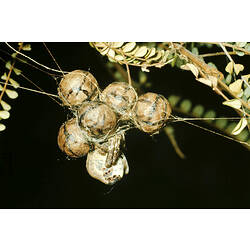General Description
Abdomen broad and triangular, upper surface rising to a pair of roughened humps towards the rear, distinctly concave along midline. Legs folded against body. Body of male and female similar in colour, mottled brown, black and cream. Body of females up to 12 mm, males up to 2.5 mm long.
Biology
This spider has been described as the master of camouflage, its colour pattern resembling a bird dropping. Another common name for the species is the death's head spider, due to the supposed resemblance of the body colours to a skull. The bird-dropping spider is a sedentary spider found sitting on a leaf or suspended underneath its egg cases. The egg cases, numbering up to 13, are large (12-14 mm in diameter), dark brown spheres with black criss-cross markings. This spider feeds at night, almost exclusively on male moths. It sits with forelegs outstretched awaiting the approach of prey. The spider attracts the moth by releasing a sex pheromone or smells similar to that produced by female moths.
Distribution
South-western and eastern mainland Australia and Tasmania.
Habitat
Foliage in woodlands, dry sclerophyll forests, orchards and agricultural areas.
More Information
-
Animal Type
-
Animal SubType
-
Brief Id
Mottled brown and white, resembles a bird dropping. Constructs a web to suspend egg cases, not to catch food.
-
Maximum Size
25 mm
-
Habitats
-
Where To Look
-
Diet
Insects
-
Hazards
The bite is not considered dangerous but could possibly result in a local reaction (may include redness, swelling, burning or itching at site of bite).
-
Endemicity
-
Conservation Statuses
CITES: Not listed, FFG Threatened List: Not listed, EPBC Act 1999: Not listed, IUCN Red List: Not listed
-
Web
Hunter
-
Taxon Name
-
Scientific Author
(Koch, 1867)
-
Common Name
Bird-dropping Spider
-
Kingdom
-
Phylum
-
Subphylum
-
Class
-
Order
-
Infraorder
-
Family
-
Genus
-
Species Name
excavata



